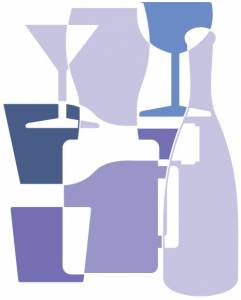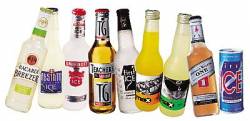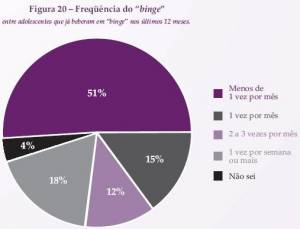« Regional Economic Integration and Consumer Protection | Home | Two More World Bank Carbon Facilities »
Alcohol Consumption in Brazil III: Adolescent Drinking
By Keith R | October 12, 2007
Topics: Food/Beverage Issues, Health Issues | No Comments »
 At end-2005, Latin America and the Caribbean (LAC) resolved to undertake a regional effort to combat alcohol consumption under the guidance of the Pan American Health Organization (PAHO). As they do, they’ll likely study the efforts of Brazil to take the lead on the issue. This past spring Brazil adopted a national policy and not long thereafter issued its initial spate of public service announcements on the topic.
At end-2005, Latin America and the Caribbean (LAC) resolved to undertake a regional effort to combat alcohol consumption under the guidance of the Pan American Health Organization (PAHO). As they do, they’ll likely study the efforts of Brazil to take the lead on the issue. This past spring Brazil adopted a national policy and not long thereafter issued its initial spate of public service announcements on the topic.
Then at end-August Brazil’s National Anti-drug Secretariat (SENAD) released the results (in Portuguese) of a nationwide survey on that country’s alcohol consumption and linked social problems that it is using to shape and justify its anti-alcohol program. It’s also likely to be a model for similar surveys to be undertaken by other LAC nations. I also suspect that its data will be studied by alcohol and advertising industry executives just as much as it will by public health officials…
Given the wealth of information the survey provides, I am treating it here on The Temas Blog in four parts. In Part I I examined the general data on consumption by adults (18 or older). In Part II, I looked at “binge drinking.” Here in Part III I’ll examine drinking among Brazilian adolescents. In Part IV, I’ll discuss what the survey found about drunk driving, as well as public support for possible policy measures to address the alcohol issue.
How Many Drink
Legally speaking, kids under 18 cannot buy or consume alcoholic beverages in Brazil. In practice, however, there are few barriers or official penalties for them doing so. Hence it is not entirely a surprise that the survey found that 34% of survey participants under age 18 had a drink the year before. 24% actually claim to drink at least once a month (28% among boys, 20% among girls). 9% of the boys claim to drink every week.
When They Start
Asked what age that they started drinking beyond a couple of experimental sips, the average of the replies for adolescents (under 18) was 13 years and nine months old. In contrast, young adults (18-25) asked the same question gave as their average age 15 years and three months. Asked when they started drinking regularly, the underage set replied 14 years, six months, while the young adults said 17 years, three months. It’s hard to escape the conclusion that the earlier kids have their first real drink, the earlier they become regular drinkers. It’s also notable the substantial difference in transitions from first plunge to regular consumer: only nine months for the under-aged, two years for the young adults. A question of relative maturity levels, perhaps?
What They Drink
The survey found that the majority of the under-age drinkers consumed beer or chope (draft beer) — 52% overall, 53% for the boys, 50% for the girls. Second place was wine: 35% overall, 32% for boys, 38% for girls. Third place was distillates — whiskey, vodka, rum, cachaça, pinga — 7% overall, but with a big divide between genders: boys 10%, girls just 4%.
 Last came the so-called “ice drinks,” distillates mixed with either soft drinks (such as whiskey with Guaraná — no, I’m not making that up, it does exist) or processed juices. [Brazilians are expected to consume 22,400 liters of ice drinks in 2007, with the market growing at 10-20% per annum.] Among the adults consumption in this category barely registered, but not so among under-aged drinkers: 6% overall, with as much as 8% for girls and 5% for boys. Thus it would not be surprising if any Brazilian government effort aimed at stopping under-age drinking picked “ice drinks” as a main target.
Last came the so-called “ice drinks,” distillates mixed with either soft drinks (such as whiskey with Guaraná — no, I’m not making that up, it does exist) or processed juices. [Brazilians are expected to consume 22,400 liters of ice drinks in 2007, with the market growing at 10-20% per annum.] Among the adults consumption in this category barely registered, but not so among under-aged drinkers: 6% overall, with as much as 8% for girls and 5% for boys. Thus it would not be surprising if any Brazilian government effort aimed at stopping under-age drinking picked “ice drinks” as a main target.
Drinking Frequency and Intensity
The under-age respondents that said that they drink were asked how much they tend to drink each time. A solid majority of girls, 69%, said that they keep it to two doses* or less. Only 41% of the boys did so. Instead, a solid majority of the boys (58%) drinks three or more doses, a full quarter (25%) 5-11 doses. By contrast, only 11% of the girls ever went above four doses.
17% of the boys and 9% of the girls say that they drink at least once a week.
SENAD defines “binge drinking” as having five or more doses* at one drinking session for men, four or more for women. While many different factors can influence what problems come and how they manifest during binge drinking (accidents, violence, etc.), studies of the phenomenon in other countries suggest that while binging may be more sporadic, it often brings higher social and health costs than does continued use and dependence on alcohol.
In the survey, 21% of the under-aged Brazilian boys and 12% of the girls said that they had done binge drinking at least once in the prior year. Those figures alone might be worrisome enough for Brazilian health officials, but it gets worse. When the adolescents who admitted to having binged at least once were asked how often they engaged in binge drinking, 18% said that they did it every week, 12% said that they binge 2-3 times per month, and 15% said that they binge at least once a month.
______________________________
Desde a Secretaria Nacional Antridrogas (SENAD) do Brasil:
Adolescentes começam a beber cada vez mais cedo
Levantamento inédito da Secretaria Nacional Antidrogas (Senad) aponta que a idade média do início do consumo de bebidas alcoólicas pelos adolescentes é menor que a de jovens adultos. A pesquisa revela ainda que 35% dos jovens de 14 a 17 anos consomem bebidas alcoólicas uma vez por ano
Adolescentes e jovens adultos apresentam diferenças na idade média para começar a ingerir bebidas alcoólicas e no início do consumo regular. Essa é uma das conclusões do I Levantamento Nacional sobre os Padrões de Consumo de Álcool na População Brasileira.
Segundo a pesquisa, jovens de 14 a 17 anos começaram a beber, em média, com 13 anos e 9 meses, enquanto os adultos começam com 15 anos e 3 meses. Já os jovens de 14 a 17 responderam que iniciam o consumo regular de bebidas alcoólicas, em média, com 14 anos e seis meses, enquanto os maiores de 18 anos, com 17 anos e 3 meses.
Em um universo de adolescentes representativo das várias regiões do País e de áreas urbanas e rurais, quase 35% dos adolescentes menores de idade consomem bebidas alcoólicas ao menos 1 vez no ano. E 24% dos adolescentes bebem pelo menos 1 vez no mês.
O beber em grande quantidade com maior risco em um curto espaço de tempo, ou o beber em binge, é a prática que mais deixa o adolescente exposto a uma série de problemas de saúde e sociais. Os riscos vão desde acidentes de trânsito – o evento mais comum e com conseqüências mais graves – até o envolvimento em brigas, vandalismo e a prática do sexo sem camisinha.
Entre os meninos e meninas que já beberam 4 ou mais ou 5 ou mais doses (essa quantidade é estipulada internacionalmente para o binge) em uma única ocasião nos últimos 12 meses, metade o fez menos de 1 vez por mês. Por outro lado, 30% deles beberam em binge 2 vezes por mês ou mais. Assim, uma parte significativa dos adolescentes que bebem grandes quantidades apresenta tal comportamento com regularidade.
Quase metade dos meninos adolescentes que beberam no último ano consumiu 3 doses ou mais por situação habitual. Há diferenças entre meninos e meninas no que diz respeito à quantidade de álcool ingerida habitualmente. Quase um terço dos meninos que bebem consumiu 5 doses ou mais no último ano, contrastando com 11% para as meninas.
E 13% do total dos adolescentes apresentam padrão intenso de consumo de álcool. Além disso, outros 10% dos adolescentes consomem ao menos 1 vez no mês e potencialmente em quantidades arriscadas.
Aproximadamente, metade das doses consumidas por adolescentes é de cerveja ou chope. Para chegar a essa conclusão, cruzaram-se dados sobre a quantidade de doses consumidas de cada bebida e a freqüência com que são consumidas.
Os vinhos tiveram também uma participação importante, com mais de 30% das doses consumidas por adolescentes. Não houve nenhuma diferença significativa entre os gêneros no que diz respeito aos tipos de bebida (embora os meninos tivessem uma tendência a beber mais destilados do que as meninas.
* a dose is 10-12 grams of alcohol, which in the Brazilian context on average equals a 350 ml beer or draft, 90 ml of wine, 30 ml of a destillate or a small bottle of an “ice” drink.
Tags: alcohol consumption, alcoholic beverages, alcoholism, alcoolismo, beber em binge, bebidas, bebidas alcoólicas, beer, binge drinking, Brasil, Brazil, cachaça, cerveja, cerveza, chope, distillates, drinks, Guaraná, ice drinks, jugos, juices, OPAS, OPS, PAHO, pinga, refrescos, refrigerantes, ron, rum, SENAD, soft drinks, survey, under-age drinking, vinho, vino, vodka, whiskey, wine



